
Design for Manufacturing (DFM) Complete Guide
What is DFM?
DFM stands for “Design for Manufacturing” or “Design for Manufacturability”. Design for Manufacturing (DFM) is both a philosophy and a practice that bridges the gap between design intent and manufacturing reality. At its heart, DFM is about designing products so they can be produced efficiently, reliably, and at scale, without compromising creativity or quality. DFM helps engineers make process-oriented design and production-friendly design, so that products can be easily manufactured.
The term “Design for Manufacturing” gained prominence through the pioneering work of Geoffrey Boothroyd and Peter Dewhurst in the early 1980s, who developed structured methods to evaluate how easily a product could be made and assembled. Their work shaped the foundation of modern product development, transforming design from a siloed activity into a collaborative engineering process. Today, DFM is an integral part of every successful design studio and manufacturing-driven innovation team around the world.
As products became more complex, designers and engineers realized that even the most brilliant ideas could fail if they were too difficult or expensive to produce. In the 1970s, the growing separation between industrial design and manufacturing engineering created friction, beautiful designs met practical roadblocks. Hence Design for Manufacturing emerged as the philosophy that reunited both worlds, emphasizing harmony between form, function, and fabrication. By aligning creative intent with production methods, it brought design and engineering back into collaboration, where true innovation happens.
Over time, DFM evolved into a mindset that drives efficiency, quality, and sustainability. It encompasses related disciplines like Design for Assembly (DFA), Design for Manufacture and Assembly (DFMA), and Design for Additive Manufacturing (DfAM). In today’s context, DFM represents more than a method: "Design for Manufacturing is a commitment to excellence that ensures ideas move smoothly from sketch to scale, from prototype to production. It’s the art and science of bringing ideas to life, blending creativity with precision, and crafting designs that are not only beautiful, but also buildable."
"Design for Manufacturing is a commitment to excellence that ensures ideas move smoothly from sketch to scale, from prototype to production. It’s the art and science of bringing ideas to life, blending creativity with precision, and crafting designs that are not only beautiful, but also buildable."
- Vyasateja Rao – Founder, Analogy
This article is a part of the Design for Manufacturing (DFM) series:
- Design for Manufacturing (DFM) Complete Guide – Analogy
- DFM Glossary: 100 Commonly Used Terms In Design for Manufacturing
- DFM Examples: Real World Case Studies & Visual Gallery
- DFM Checklist: Design for Manufacturing Best Practices
- DFM Mistakes: 50 Common DFM Mistakes You Must Avoid
- DFM Tools: 50 DFM Tools, Software, and Techniques
DFM History, Timeline, and Evolution
The roots of Design for Manufacturing trace back to the early 20th century, when industrial production began shifting from craft-based methods to standardized manufacturing systems. The foundations were laid during the Industrial Revolution, but it was the rise of mass production in the early 1900s that truly shaped the need for manufacturing-conscious design. As industries like automotive and aerospace grew, engineers started realizing that smart design could significantly reduce production cost and complexity. This was the era of Henry Ford, whose assembly-line innovations inspired generations of designers to think about efficiency, repeatability, and manufacturability.
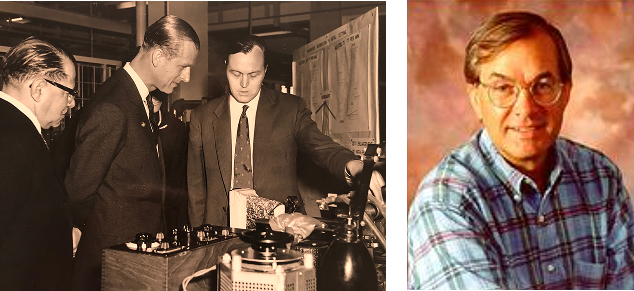

By the 1960s and 1970s, product complexity had increased, and design and manufacturing teams often worked in silos. This disconnect created challenges, products looked great on paper but were expensive or impractical to produce. Researchers and engineers began exploring systematic ways to evaluate how design decisions influenced manufacturing. Around this time, early concepts of Design for Assembly (DFA) and Design for Manufacturing (DFM) started appearing in academic and industrial research, laying the groundwork for a more integrated approach.
Below is a timeline of the evolution of DFM, DFMA & DFA over the years:
- 1960s: Early research begins on automated assembly, focusing on handling and orienting small parts.
- 1970: A foundational handbook is published on feeding small parts. First coding systems for evaluating assembly processes are introduced.
- 1976: A structured coding system is created to classify parts based on how easy they are to assemble.
- 1978: Research expands into Design for Manufacture (DFM), supported by National Science Foundation (NSF) funding.
- 1980: Geoffrey Boothroyd partners with Peter Dewhurst at the University of Rhode Island, merging DFM with DFA concepts.
- 1981: The first Design for Assembly (DFA) software is released on an Apple II Plus, offering engineers real-time feedback.
- 1983: Boothroyd Dewhurst, Inc. is founded to develop and commercialize DFM/DFA tools.
- 1985: A dedicated DFM module is added to the software, and the combined approach becomes known as DFMA.
- 1991: Boothroyd and Dewhurst receive the National Medal of Technology for their contributions to manufacturing design.
- 2005: DFM tools start integrating with advanced CAD software, improving workflow and ease of use.
- 2010s: More detailed cost models and simulation features are added, helping designers make smarter manufacturing decisions early in development.
- 2015: Cloud-based DFM platforms begin emerging, enabling real-time collaboration and faster iteration across global teams.
- 2020: AI and machine learning start playing a role in automated DFM analysis, identifying manufacturing issues directly from CAD models.
- 2025: DFM tools now include real-time supplier feedback, sustainability analysis, and automated design optimization, making them central to smart manufacturing and Industry 4.0 strategies.
The Pioneers Of DFM
In the early 1980s, Geoffrey Boothroyd and Peter Dewhurst formalized these ideas into structured frameworks, developing the DFMA methodology (Design for Manufacture and Assembly). Their methods provided engineers with measurable ways to simplify designs, reduce part counts, and improve production speed, all the while maintaining product integrity. Their work became a cornerstone for modern product development and earned widespread recognition, including the National Medal of Technology in 1991.
Watch this video to understand Design for Manufacturing.
Brands Like General Electric, Toyota, And Boeing Adapted DFM
As DFM gained adoption through the 1980s and 1990s, leading brands like General Electric, Toyota, Boeing, and Procter & Gamble began embedding DFM principles into their design culture. These companies realized that manufacturability wasn’t just a production advantage; it was a strategic differentiator. The rise of concurrent engineering and lean manufacturing further amplified DFM’s importance, encouraging real-time collaboration between designers, engineers, and manufacturers.
Today, DFM continues to evolve in the era of Industry 4.0 and digital manufacturing. With advances in additive manufacturing (DfAM), simulation tools, and AI-driven design optimization, the concept has expanded beyond physical production into the realm of digital creation and virtual prototyping. Global design and innovation studios, like Analogy, integrate DFM thinking from day one, ensuring every concept is not only visionary but also manufacturable, scalable, and sustainable.
This evolution reflects how DFM has matured from a technical guideline into a creative philosophy that empowers innovators to bring ideas to life with confidence and precision.
DFM Real-World Examples: Visual Gallery & Case Studies
Design for Manufacturing (DFM) transforms ideas into products that are not only innovative but also easy to produce, reliable, and cost-effective. From electronics and automotive parts to medical devices and industrial equipment, real-world examples show how smart design choices, material selection, and assembly strategies streamline production. Our visual gallery and case studies illustrate these principles in action, highlighting creativity, efficiency, and manufacturability.
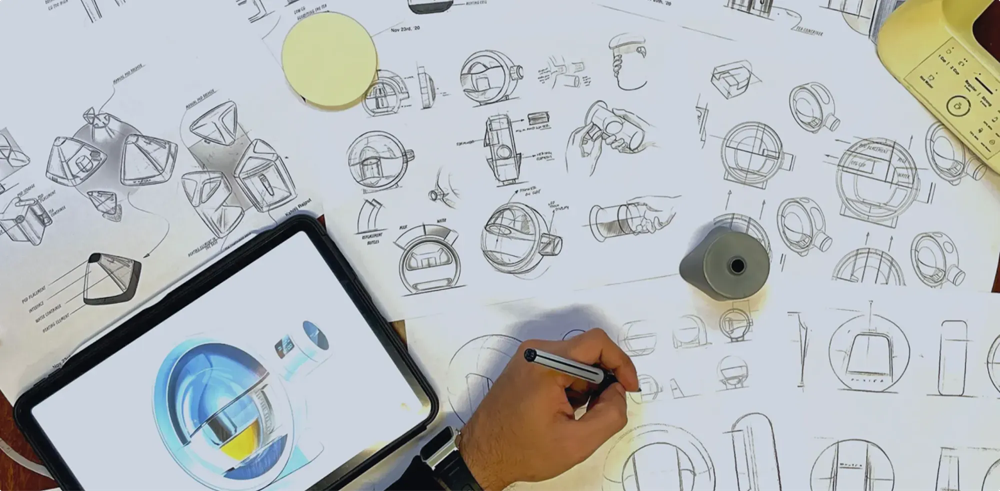
DFM in Action:
1. Consumer Electronics: Compact, modular designs with precision tolerances enable efficient mass production while improving reliability and user experience.
2. Automotive Design: Standardized components, optimized tolerances, and modular platforms reduce costs, waste, and assembly complexity.
3. Medical Devices: Precise, safe, and easy-to-assemble designs meet strict regulatory standards while speeding up production.
4. Plastic Products: Thoughtful part geometry, draft angles, and material choices reduce defects and scale efficiently.
5. Industrial Equipment: Modular, maintainable designs improve assembly efficiency, reliability, and long-term performance.
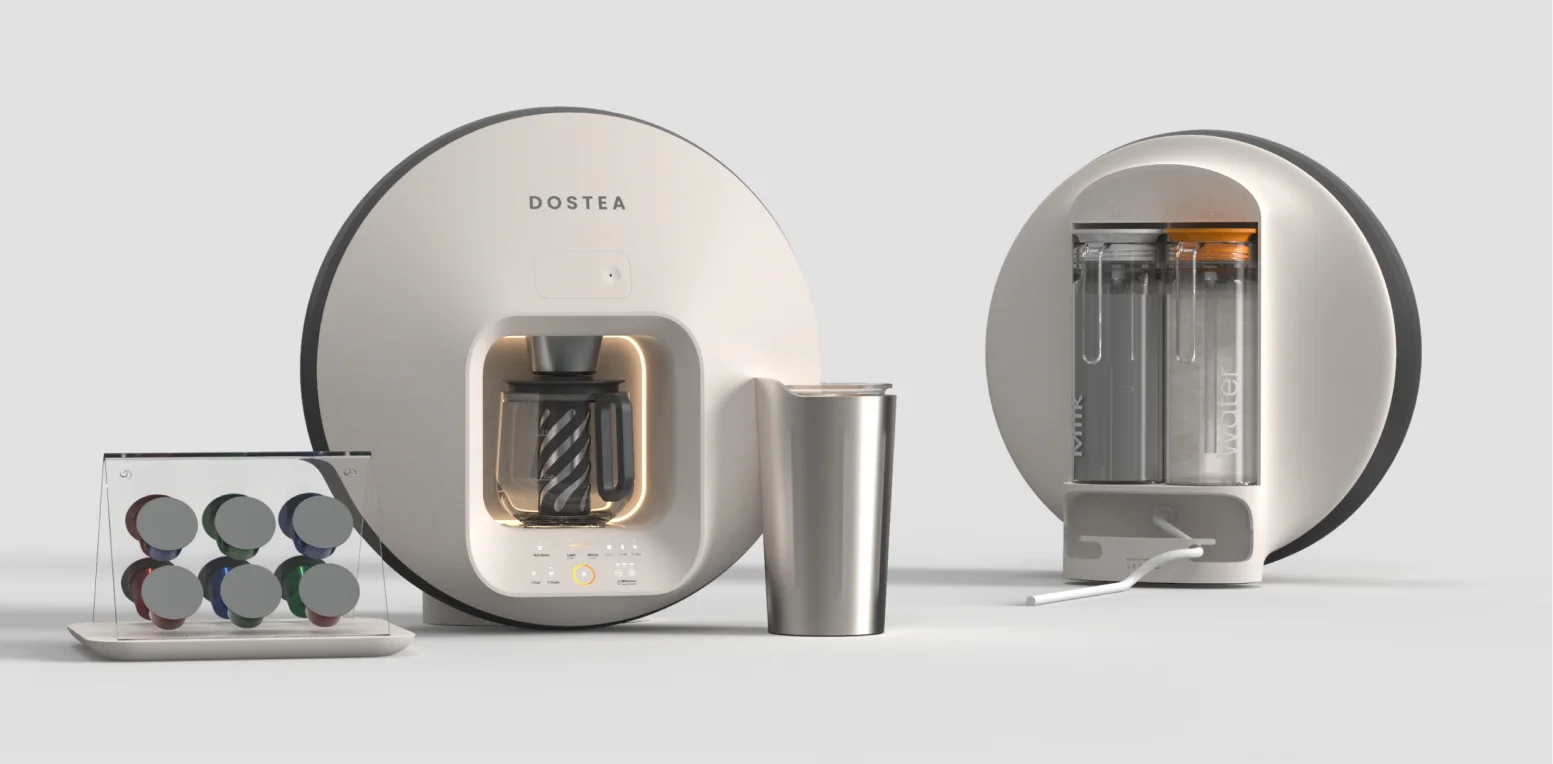
DFM Case Studies by Analogy:
1. Zook – Electric Hookah: Modern, ergonomic, and modular, designed for seamless assembly.
2. Dostea – Tea Maker: Ergonomic, stylish, and cost-effective appliance design guided by DFM.
3. Eume – Wearable tech designed with integrated electronics, optimized for manufacturability and comfort.
4. IoT Smart Devices – Sleek hardware and user-focused design optimized for assembly and reliability.
5. Roto Evaporator – Laboratory equipment redesigned for intuitive user interaction and efficient assembly, blending industrial design with practical engineering.
View a bigger list of DFM examples in real life. For viewing more cool product design projects, check out Analogy's portfolio.
DFM bridges creativity and production, turning bold ideas into reliable, scalable products. Studying real-world Design for Manufacturing examples and case studies shows how early planning, smart material choices, and thoughtful assembly strategies save time, reduce costs, and enhance both user experience and manufacturability. These stories inspire designers to apply proven strategies and make complex designs production-ready.
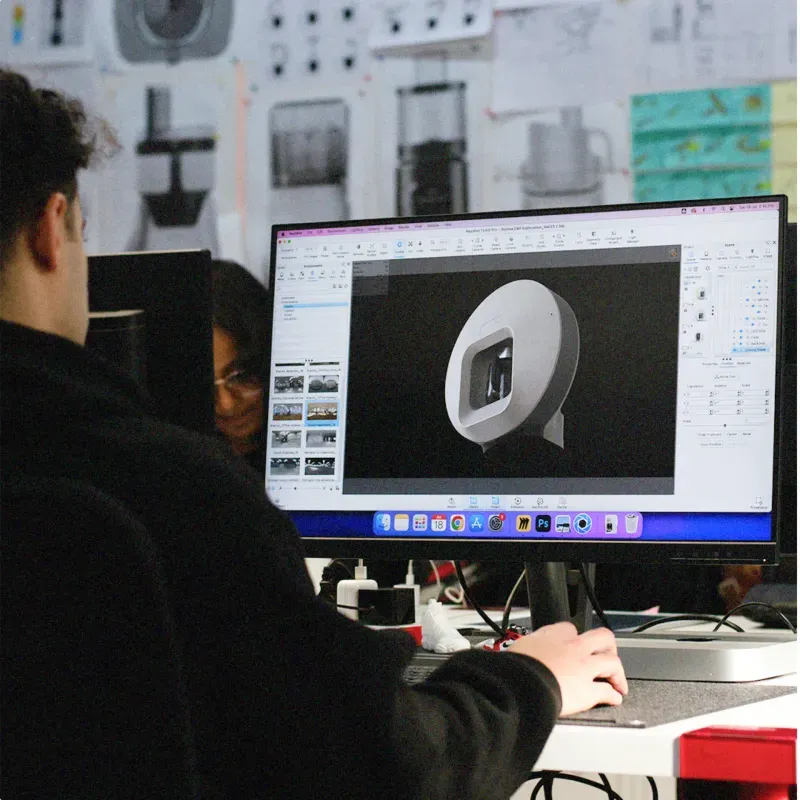
DFM Process: 8 Steps In Design for Manufacturing
Design for Manufacturing (DFM) is a cornerstone of the product creation journey. The 8 steps of the DFM process ensure that concepts not only look and feel right but can also be efficiently produced, assembled, and scaled. Integrating DFM early allows engineers and designers to foresee potential manufacturing challenges, optimize materials, define tolerances, and simplify assemblies without compromising aesthetics or functionality. Whether it’s a sleek consumer product, a complex industrial device, or a PCB-based electronic system, a well-executed DFM process reduces risk, improves quality, and accelerates time to market. At Analogy, DFM is treated as a collaborative framework where design, engineering, and manufacturing expertise converge to bring ideas to life.
Through this DFM framework, every stage of product creation benefits from early manufacturability analysis, collaborative engineering, and iterative refinement. From PCB to mechanical assemblies, from sketches to full-scale production, DFM ensures that products are beautiful, functional, and buildable, bringing ideas to life with precision and confidence.
Step 1: Product Discovery
The journey begins with research, user insights, competitor mapping, and requirement definition. This phase defines the problem, audience, and product goals while also initiating early DFM thinking. By evaluating materials, assembly feasibility, and production methods from the outset, teams identify potential bottlenecks before detailed design begins. Concept sketches, preliminary CAD, and product briefs form the foundation for informed design decisions.
Output: Product brief, use cases, initial concept sketches, and feasibility notes.
Step 2: Industrial Design (ID)
Industrial design translates ideas into visual and experiential forms. Focus areas include form, aesthetics, ergonomics, and brand language, expressed through sketches, renderings, and CAD models. Early DFM review ensures that chosen shapes, materials, and finishes can be manufactured without unnecessary complexity. Designers and engineers collaborate to balance creativity with production feasibility, refining aspects like color, material, and surface finish direction.
Output: ID CAD models, color-material-finish (CMF) direction, and preliminary manufacturability insights.
Step 3: Mechanical Design
Mechanical engineering is where the DFM process becomes critical. Engineers refine CAD assemblies, split parts strategically, and determine assembly structures that are robust and simple. Detailed DFM analysis covers draft angles, wall thickness, ribs, and structural strength, while DFA (Design for Assembly) principles guide fastener choices, snap-fit designs, and joining methods. Material selection, tolerances, and strength validation are finalized to ensure production readiness.
Output: Full 3D assembly CAD, optimized for prototyping and production.
Step 4: Electrical Engineering
Electrical design integrates functionality without compromising manufacturability. This includes PCB layout, component selection, wiring harness design, and mechanical fit verification. DFM principles are applied to ensure manufacturable PCB designs and to avoid integration issues. Thermal management, EMI considerations, and ease of assembly are evaluated in parallel with mechanical constraints.
Output: PCB Gerber files, Bill of Materials (BOM), wiring harness layout, and manufacturability validation.
Step 5: Prototyping & Testing
Prototyping bridges concept and production. Visual and functional prototypes are created using 3D printing, CNC machining, or soft tooling. Pilot batches of 50–100 units allow for testing fit, function, and assembly. Iterative feedback informs refinements to CAD, mechanical structures, and PCB layouts. Early DFM prototyping ensures that production challenges are identified and resolved before scaling.
Output: Working prototypes validated for manufacturability and user testing.
Step 6: Pilot Production
Pilot production tests the manufacturing ecosystem before mass output. Mould design, including core/cavity layout, gating, ejection, and cooling channels, is finalized. Toolmakers perform a detailed DFM review to ensure consistency and quality. Pre-production batches validate surface finishes, tolerances, and assembly processes. This step ensures the transition from design to scalable production is smooth and reliable.
Output: Ready-to-ship mass production parts, validated tooling, and production processes.
Step 7: Mass Manufacturing
Mass manufacturing scales validated designs while maintaining quality, efficiency, and cost-effectiveness. Optimized assemblies, refined tolerances, and established DFM protocols allow production to meet demand without compromise. Material sourcing, supply chain management, and manufacturing oversight ensure that products are consistent, reliable, and built to last. This phase transforms prototypes into market-ready products while maintaining production excellence.
Output: Large-scale production-ready products with consistent quality.
Step 8: Launch & Startup Support
The final stage ensures the product reaches the market successfully. Teams coordinate with vendors, optimize costs, and manage packaging design. Certification processes such as CE, BIS, or ISO are completed, while post-launch feedback informs future iterations. DFM principles continue to guide version improvements, ensuring scalability, manufacturability, and innovation remain aligned.
Output: Market-ready product supported by a reliable manufacturing ecosystem.
DFM, DFA, DFMA, DFX & DFC
Designing a product is about more than just aesthetics or functionality. Methodologies like DFM, DFA, DFMA, DFX, and DFC must be used as frameworks in product design. Each of these frameworks provides a structured approach to ensure that design decisions align with production realities, assembly efficiency, operational excellence, and financial goals. Together, they create a holistic toolkit for innovators, engineers, and designers to transform concepts into high-quality, scalable products.
While DFM focuses on making products easier to manufacture, DFA ensures they are simple to assemble. DFMA combines both principles to optimize production and assembly together. DFX broadens the scope to include quality, reliability, serviceability, and sustainability, while DFC specifically addresses cost optimization throughout the design and production process. Understanding and applying these methodologies allows teams to make informed decisions, reduce risk, and deliver products that are not only functional and beautiful but also buildable and commercially viable.
To truly bring your ideas to life, a product must be manufacturable, assembly-friendly, cost-effective, and built to excel.
What is DFM?
DFM (Design for Manufacturing) is the practice of designing products so they can be produced efficiently, reliably, and at scale. It focuses on optimizing materials, tolerances, assembly methods, and production processes to reduce costs and risks. DFM encourages collaboration between designers and engineers from the earliest stages of product creation. The goal is to create buildable, high-quality products without compromising creativity or aesthetics.
What is DFA?
DFA (Design for Assembly) is a methodology that ensures products can be assembled easily, quickly, and with minimal errors. DFA focuses on simplifying assemblies, reducing the number of parts, and choosing efficient fastening or joining methods. By integrating DFA early, teams minimize labor, reduce assembly time, and improve product reliability. It complements DFM by ensuring that once a product is manufacturable, it is also easy to put together.
What is DFMA?
DFMA (Design for Manufacture and Assembly) combines the principles of DFM and DFA into a single framework. It allows engineers to analyze both manufacturing feasibility and assembly efficiency in tandem. DFMA is often used in complex mechanical, electronic, and industrial products to optimize cost, material usage, and production workflow. By applying DFMA, teams can identify redundant parts, streamline processes, and reduce overall production time.
What is DFX?
DFX (Design for Excellence) is a broader philosophy that covers multiple design considerations beyond manufacturing and assembly. DFX includes reliability, serviceability, safety, testability, and environmental sustainability. The goal is to create products that excel across all key performance and operational metrics. It encourages cross-functional collaboration to ensure products meet both business and user expectations.
What is DFC?
DFC (Design for Cost) focuses specifically on minimizing production costs while maintaining quality and functionality. DFC involves material selection, process optimization, and part simplification to achieve the best cost-to-value ratio. It often works alongside DFM and DFMA, providing a financial lens to manufacturing and assembly decisions. By designing with cost in mind, teams ensure products are competitive and profitable from day one.
DFM vs DFA
DFM (Design for Manufacturing) and DFA (Design for Assembly) are closely related but focus on different aspects of product creation. DFM ensures that a product can be manufactured efficiently, considering materials, production methods, tolerances, and process limitations. It looks at the design from the manufacturer’s perspective, asking whether the product can be produced reliably, at scale, and without unnecessary complexity.
DFA, on the other hand, focuses specifically on how the product comes together during assembly. It encourages simpler assemblies, fewer parts, and faster, error-free assembly methods. While DFM ensures the parts can be made, DFA ensures those parts can be put together easily. Using both approaches together allows teams to create products that are not only buildable but also quick and efficient to assemble.
DFM vs DFMA
DFMA (Design for Manufacture and Assembly) is essentially the combination of DFM and DFA into a single methodology. DFM looks at production feasibility, while DFA looks at assembly efficiency. DFMA considers both, providing a holistic view of product optimization from the factory floor to the assembly line.
When a team applies DFMA, they can identify opportunities to simplify parts, reduce costs, and streamline processes in one unified analysis. While DFM alone may improve manufacturability, DFMA ensures that the product is also efficient to assemble, reducing labor, errors, and production time. This makes DFMA an invaluable tool for complex mechanical, electronic, and industrial products.
DFM vs DFX
DFX (Design for Excellence) is broader than DFM. While DFM focuses on manufacturability, DFX looks at multiple dimensions of a product’s performance, such as reliability, maintainability, serviceability, sustainability, and safety. It is a more strategic and holistic approach to design, incorporating manufacturability as one of many considerations.
The key difference is that DFM is about making products buildable, whereas DFX is about making products excellent across all key performance areas. When DFM is applied within a DFX framework, teams not only ensure efficient manufacturing but also create products that are robust, durable, and ready for long-term use.
DFM vs DFC
DFC (Design for Cost) focuses specifically on reducing production expenses while maintaining quality and functionality. DFM ensures a product can be manufactured efficiently, but it does not always prioritize cost reduction as the main goal. DFC applies financial considerations to material selection, process choice, and part simplification.
The difference lies in perspective: DFM looks at feasibility, DFC looks at cost optimization. Combining DFM and DFC ensures that products are not only buildable but also profitable. Designers can make informed decisions that balance manufacturability with budget constraints, creating products that are both practical and commercially successful.
DFM Glossary: Commonly Used Terms In Design for Manufacturing
This glossary highlights the most commonly used words in DFM, along with simple definitions and context. It covers terms related to materials, processes, assembly, prototyping, cost, and optimization, providing a quick reference guide for anyone involved in product creation. By understanding these words, innovators and designers can bridge the gap between concept and production, ensuring that ideas move smoothly from sketch to market-ready product.
Understanding the language of Design for Manufacturing is essential for anyone looking to bring ideas to life. From engineers to entrepreneurs, being familiar with key DFM terms helps teams communicate clearly, make informed decisions, and anticipate manufacturing challenges. A well-rounded grasp of these concepts ensures that design decisions are not only creative and innovative but also practical, efficient, and production-ready.
- Manufacturability – The ease with which a product can be produced efficiently and reliably.
- Tolerance – The allowable variation in a part’s dimensions to ensure proper fit and function.
- Assembly – The process of putting together parts to create the final product.
- Prototype – An early version of a product used to test design and manufacturability.
- CAD (Computer-Aided Design) – Digital modeling used to design parts and assemblies for production.
- Material – The substance used to make a product, chosen for performance, cost, and manufacturability.
- Fastener – Hardware like screws, bolts, or snaps used to join components together.
- Cost Optimization – Adjusting design and manufacturing processes to reduce production expenses.
- DFMA – A combined methodology of Design for Manufacture and Assembly to optimize production and assembly.
- Feasibility – The practical assessment of whether a design can be manufactured successfully.
View a complete list of Design for Manufacturing glossary.
DFM Principles: Key Guidelines for Manufacturable Product Designs
Design for Manufacturing principles provide a practical framework to create products that are both innovative and easy to produce. These principles help designers, engineers, and innovators make decisions that balance aesthetics, functionality, and manufacturability. By following these guidelines, products move smoothly from concept to prototype, pilot runs, and full-scale production without unnecessary delays or costs.
Applying DFM principles ensures that designs are efficient, cost-effective, and reliable, while still allowing room for creativity and user-focused innovation. From simplifying parts to optimizing materials and collaborating with production teams, these principles guide every stage of product development, creating a seamless path from idea to market-ready product. They bridge the gap between engineering intent and manufacturing reality, allowing designers to create products that are not only innovative and sleek but also buildable and scalable.
By following proven principles, innovators can ensure their ideas move smoothly from concept to reality, avoiding common pitfalls that slow down production or inflate costs.
Principle 1: Simplify Parts
Simplifying parts is one of the most powerful ways to make a product manufacturable and cost-effective. By reducing the total number of components, designers can minimize assembly time, lower production costs, and reduce potential errors. Every extra part adds complexity, increases the chance of defects, and slows down production, so simplicity is key.
Simplification doesn’t mean compromising creativity, it’s about designing smarter. Components can often be combined, shapes optimized, or unnecessary features removed without affecting functionality. A simpler design also makes the product easier to maintain, test, and scale, ensuring it performs reliably throughout its lifecycle.
Principle 2: Standardize Components
Standardization involves using commonly available materials, fasteners, and processes wherever possible. By doing so, teams can reduce sourcing challenges, shorten lead times, and maintain consistent quality across production batches. Standard parts also simplify inventory management and make assembly more predictable.
Using standard components doesn’t stifle innovation, it allows designers to focus creativity where it matters most, such as form, aesthetics, and user experience. Standardization also improves collaboration between designers, engineers, and manufacturers, creating a smoother path from concept to production.
Principle 3: Design for Easy Assembly
Designing for easy assembly ensures that a product can be put together quickly and accurately. This includes considering assembly sequence, joining methods like snaps or screws, and minimizing alignment challenges. Products that are easier to assemble save labor costs, reduce errors, and accelerate production timelines.
Early collaboration with manufacturing teams is crucial for assembly-friendly design. By thinking about how parts come together during the design phase, designers can anticipate challenges, incorporate intuitive features, and create a seamless assembly process that doesn’t compromise the product’s quality or appearance.
Principle 4: Minimize Tolerances
Tolerances define how much a part’s dimensions can vary, and minimizing them wisely is key to manufacturability. Applying overly tight tolerances can increase production cost, slow down processes, and create unnecessary complexity. By setting tolerances only where they truly matter, designers ensure parts fit correctly without driving up cost or difficulty.
Balanced tolerances also improve assembly efficiency and reduce the risk of defects. DFM encourages teams to carefully analyze which dimensions require precision and which can be relaxed. This approach keeps production predictable, cost-effective, and reliable, while maintaining product quality.
Principle 5: Optimize Material Selection
Choosing the right materials is central to a manufacturable and durable product. Materials impact strength, finish, cost, and ease of production, so careful selection can enhance both performance and efficiency. Designers must consider machinability, formability, thermal properties, and aesthetic needs during material selection.
Optimized materials reduce waste, simplify manufacturing, and ensure the product meets functional requirements. When design and material choices align, products become easier to produce, maintain, and scale, all without sacrificing the sleekness, feel, or innovation that define great design.
Principle 6: Design for Manufacturability Feedback
Incorporating manufacturability feedback early ensures that potential production issues are addressed before they become costly problems. Engineers, toolmakers, and production teams can highlight challenges with assembly, tooling, or materials. This collaborative approach allows designers to refine parts, reduce errors, and improve efficiency.
DFM feedback isn’t just about fixing problems, it’s about creating a dialogue between design and production. Early input helps teams iterate smarter, make informed choices, and deliver products that are both beautiful and buildable, ensuring a smoother path from prototype to mass manufacturing.
Principle 7: Plan for Cost and Efficiency
Cost and efficiency should guide every design decision. By considering the impact of materials, processes, and assembly methods early, designers can reduce unnecessary expenses and optimize production. Efficient designs not only save money but also speed up time-to-market.
Planning for cost and efficiency doesn’t mean compromising quality or creativity. DFM encourages smart choices, like selecting scalable processes, minimizing waste, and designing with mass production in mind. This ensures that the final product is affordable, manufacturable, and maintains its intended aesthetic and functionality.
Principle 8: Ensure Quality and Reliability
Designs should be built to perform consistently over time. Ensuring quality and reliability involves incorporating features that prevent errors, simplify inspection, and allow for easy maintenance. DFM integrates quality checks into the design phase to reduce defects during production.
Reliable products build trust with customers and protect brand reputation. By thinking about durability, assembly, and serviceability upfront, designers can create products that not only look great but also withstand real-world use. This principle reinforces the connection between innovation and practical execution.
Principle 9: Collaborate Early and Often
Collaboration is at the heart of successful DFM. Designers, engineers, and manufacturing teams should work together from the very beginning to align design intent with production realities. This cross-functional teamwork reduces misunderstandings, anticipates challenges, and accelerates product development.
Early and frequent collaboration also fosters innovation. By sharing insights and knowledge, teams can balance creativity with manufacturability, ensuring that products are not just visually appealing but also buildable, cost-effective, and ready for market.
Key Takeaways from DFM Principles
Design for Manufacturing principles are more than rules, they are a strategic approach that bridges creativity and production. By applying these guidelines, designers and engineers can create products that are not only visually striking and innovative but also efficient, cost-effective, and reliable to manufacture.
Following DFM principles encourages early collaboration, smart material choices, simplified assembly, and proactive feedback, all of which reduce errors, speed up production, and enhance overall product quality. Ultimately, embracing these principles ensures that ideas move seamlessly from concept to market-ready products, delivering real impact for both creators and users.
DFM Checklist: Design for Manufacturing Best Practices
The Design for Manufacturing (DFM) Checklist helps entrepreneurs, engineers, and product creators turn great ideas into production-ready products: faster, smarter, and at lower cost. It simplifies every stage, from concept and materials to tooling, assembly, and quality control. By applying DFM principles, you can design products that are efficient, scalable, and easy to manufacture without compromising quality, bridging the gap between creative design and real-world manufacturing success.
1. Product Definition
☐ Part Name – Confirm name matches design files.
☐ Part Number – Assign consistent numbering.
☐ Function – Clearly define the product’s purpose.
☐ Environment – Note operating conditions (temp, humidity, load).
☐ Regulations – Identify required standards (UL, CE, BIS, etc.).
☐ Production Volume – Estimate annual quantity.
☐ Target Cost – Set cost per unit and cost ceiling.
2. Material Selection
☐ Material Type – Choose material family (metal, polymer, composite).
☐ Material Grade – Specify exact grade and supplier.
☐ Availability – Check global/local supply and lead time.
☐ Process Compatibility – Ensure it suits chosen process.
☐ Mechanical Properties – Verify strength, hardness, elasticity.
☐ Thermal & Chemical Stability – Match environment needs.
☐ Sustainability – Prefer recyclable or renewable materials.
View the full DFM checklist which you can follow for your Design for Manufacturing needs.
50 Common DFM Mistakes You Must Avoid
Even brilliant product ideas can fail on the factory floor if design flaws or poor material choices aren’t caught early. Design for Manufacturing (DFM) helps innovators spot these pitfalls, saving time, money, and headaches. By thinking like a DFM expert, balancing creativity with practical manufacturability, collaborating early with engineers, and iterating wisely, you can ensure your product succeeds from concept to consumer. Avoiding common DFM mistakes turns potential manufacturing nightmares into smooth, scalable production.
Below are the 50 most common DFM mistakes you should avoid:
1. Design Oversights
- Ignoring manufacturability during early design stages
- Overcomplicating part geometry
- Using non-standard or hard-to-source components
- Neglecting draft angles for molded parts
- Overlooking wall thickness uniformity
- Forgetting tolerance stack-up analysis
- Designing parts without considering assembly sequence
- Missing fillets or radii at stress points
- Using unnecessary undercuts or complex features
- Skipping DFM reviews before prototype
2. Material Mistakes
- Selecting the wrong material for production volume
- Ignoring material shrinkage or flow characteristics
- Choosing materials that are difficult to machine or mold
- Over-specifying material strength or hardness
- Ignoring surface finish compatibility with material type
You can continue reading the full list of DFM mistakes one should avoid on this page.
DFM Solutions: Making Products Easier to Manufacture
Design for Manufacturing solutions help bridge the gap between creative ideas and production reality. They guide designers and engineers to create products that are not only innovative and sleek but also efficient, reliable, and cost-effective to manufacture. By applying these solutions early and consistently, teams can avoid common pitfalls, streamline production, and bring ideas to market faster.
1. Early Design & Material Optimization
Early-stage DFM solutions focus on reviewing your design for manufacturability before prototyping. This includes evaluating part complexity, material selection, and assembly feasibility to prevent costly mistakes later in production.
By optimizing materials and simplifying parts early, innovators can reduce costs, improve efficiency, and ensure designs are scalable. This proactive approach helps products move smoothly from concept to prototype without unnecessary iterations.
2. Engineering & Process Alignment
DFM solutions help align mechanical and electrical designs with the intended manufacturing processes. Designers receive guidance on tolerances, assembly sequences, and process compatibility for CNC, injection molding, or additive manufacturing.
This ensures that designs are production-ready, cost-efficient, and reliable. Early collaboration between design and manufacturing teams reduces errors and accelerates the path to market.
3. Prototyping & Validation
Rapid prototyping and functional testing are key components of DFM solutions. Using 3D printing, CNC, or soft tooling, teams validate design intent, assembly, and manufacturability before mass production.
Incorporating feedback from prototypes allows designers to refine parts, improve fit, and eliminate potential production issues. This iterative process saves time, reduces defects, and ensures a smoother transition to full-scale manufacturing.
4. Cost, Quality & Collaboration
DFM solutions emphasize cost efficiency, quality assurance, and cross-functional collaboration. Standardizing components, simplifying assemblies, and integrating inspection points help reduce production cost and improve reliability.
Collaboration with engineers, toolmakers, and suppliers ensures every design decision balances creativity with manufacturability. By embedding DFM practices, innovators create products that are beautiful, buildable, and market-ready.
50 DFM Tools, Software, and Techniques
Design for Manufacturing (DFM) ensures products are efficient, cost-effective, and easy to produce. The right tools, software, and techniques help engineers and designers spot issues early, optimize assembly, and reduce production costs. Here’s a comprehensive list of 50 widely used DFM solutions that streamline development and boost manufacturability:
DFM Software & Tools
- DFMPro – Automated DFM analysis for various manufacturing processes.
- DFMExpress – Integrated DFM software for design validation.
- DFMNow – Free Gerber viewer and DFM solution.
- PCBflow – DFM tool for PCB design and manufacturing.
- VayoPro-DFM Expert – Advanced DFM/DFA analysis tool with 3D reporting.
- Altium Designer – PCB design software with integrated DFM features.
- Autodesk Fusion 360 – Cloud-based CAD, CAM, and CAE tool.
- SolidWorks – 3D CAD design software with DFM capabilities.
- Autodesk Inventor – 3D mechanical design software.
- Creo by PTC – 3D CAD software with advanced DFM tools.
You can view or download the full list of 50 DFM Tools, Software, and Techniques that will help your manufacturing and design needs.
Final Thoughts: Design for Manufacturing
Design for Manufacturing is more than a methodology, it’s a mindset that transforms ideas into products that are not only beautiful but buildable. Every design decision, from material choice to assembly sequence, impacts cost, efficiency, and product reliability. As you plan your next innovation, consider how early DFM thinking can save time, reduce waste, and enhance user satisfaction. Ask yourself whether your design anticipates real-world production challenges or leaves the burden entirely to manufacturing teams. By reflecting on these points, you set the stage for products that succeed both creatively and commercially.
Thinking critically about DFM also means questioning the balance between aesthetics and manufacturability.
- Are your prototypes realistic for mass production?
- Are your designs scalable, sustainable, and adaptable to future iterations?
- Could DFM principles unlock opportunities for cost optimization or faster time-to-market?
- Could small adjustments improve assembly efficiency without compromising design integrity?
These are the questions that separate ideas that remain on paper from those that thrive in the marketplace. These reflections help ensure that your creative process aligns with manufacturing realities, ultimately turning concepts into products that delight users and meet business goals. Thoughtful consideration now pays dividends in quality, efficiency, and market impact. Engaging with these considerations early encourages collaboration between designers, engineers, and manufacturers. It fosters a culture where innovation meets practical execution seamlessly.
Finally, reflect on your long-term vision for product development and how DFM will pay a role in it.
About Analogy
Analogy is a Bangalore-based product design studio dedicated to helping inventors, entrepreneurs, and innovators bring their ideas to life. We specialize in end-to-end product design services, guiding projects from the first prototype to full-scale manufacturing and market launch. Whether you have an invention ready to design or a concept that needs refinement, our team ensures that creativity, functionality, and manufacturability are perfectly balanced.
At Analogy, sustainability and thoughtful design are at the core of everything we do. Our experts combine industrial design, interaction design, design integration, and packaging design to craft products that are not only visually appealing but also optimized for production efficiency. With a global footprint, we have worked with innovators and startups across the United States, United Kingdom, Dubai, and India, delivering award-winning solutions that transform ideas into real-world products.
Our team of experienced product design and engineering consultants brings decades of combined expertise to every project. We provide mentorship, consultancy, and hands-on design guidance, ensuring that innovators can confidently navigate the journey from concept to launch. At Analogy, we don’t just design products, we create experiences, solve real problems, and enable innovations to thrive.
Blogs For Further Reading
1. Design for manufacturing and assembly: A review on integration with design sustainability
3. The Role of Industrial Designers in Achieving the Green Economy
4. Sustainable Product Development in a Circular Economy
5. The role of Industrial Design in creating Sustainable products
6. Your guide to New Invention Ideas and Sparking Creativity
Sources & Citations
History of Boothroyd Dewhurst and DFMA
Design for Manufacturing and Assembly Methods Literature Review
A History of Design for Manufacturing and Assembly
About The Authors

Vyasateja Rao – Founder, Analogy
Vyasateja Rao is a multi-award-winning product designer with over two decades of experience, and the visionary founder of Analogy, a Bangalore-based industrial and interaction design studio. He specializes in crafting memorable and innovative experiences for both physical and digital products. After earning a Masters in Industrial Design from North Carolina State University in 2007, Vyasateja worked across the United States, Hong Kong, China, Korea, Taiwan, Singapore, and India, collaborating with Fortune 500 companies and leading design studios. His studio has received international recognition, including the Red Dot, IBDC, Singapore Design Award, and multiple patents for product innovation. Vyasateja has designed for global clients such as Panasonic, Unilever, Amazon, Marvel, and Cellairis, blending creativity with manufacturability to create breakthrough products. Beyond design, he mentors aspiring designers, teaching the importance of contrast, surprise, and hidden artifacts in creating compelling experiences.

Dinesh Krishnamoorthy – Lead Design Engineer, DFM Expert
Dinesh Krishnamoorthy is a Design for Manufacturing (DFM) specialist with 9 years of experience in product engineering and production optimization. He graduated with a B.E. in Mechanical Engineering from Dhanalakshmi Srinivasan Engineering College (Anna University), Perambalur, and began his career as a Quality Engineer. His passion for design led him to Butterfly Gandhimathi Appliances Ltd, where he gained hands-on experience in both product design and manufacturing. This exposure shaped his deep understanding of DFM principles, learning directly from mold designers and production teams. At Analogy, Dineshkumar integrates manufacturing considerations from the earliest design stages, ensuring efficient, cost-effective, and production-ready products. He believes DFM transforms CAD designs into real, launch-ready products, making the engineering process smoother and more impactful.
FAQs
news & insights
Continue reading
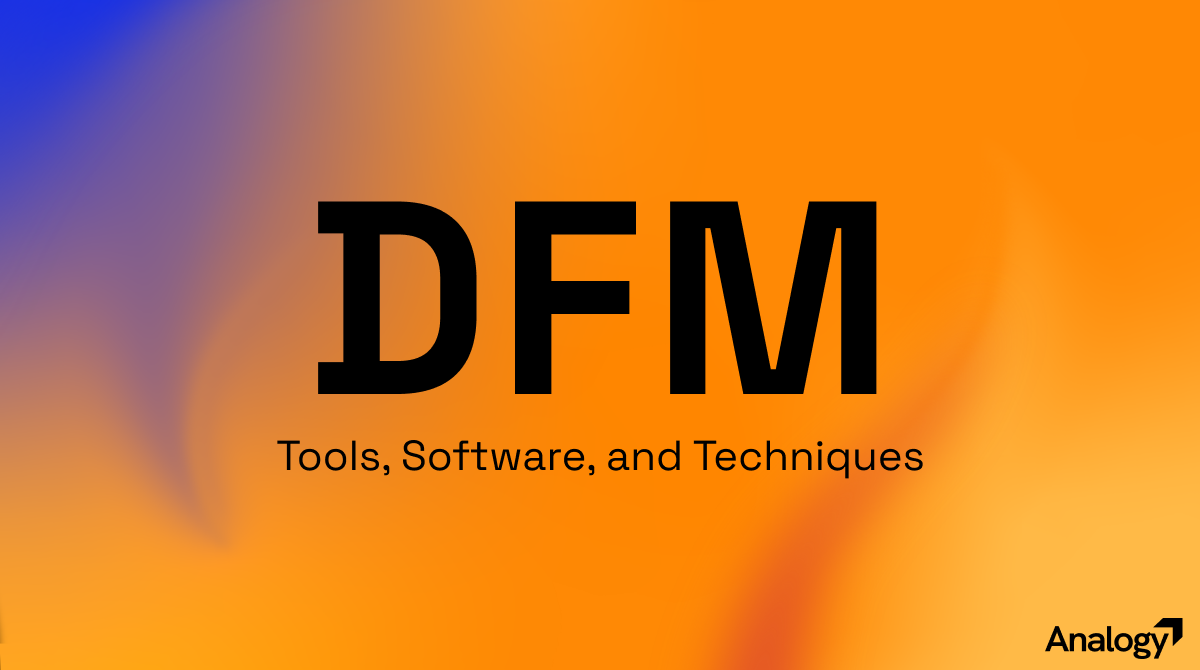
50 DFM Tools, Software, and Techniques
The following list highlights 50 widely used DFM tools, software solutions, and techniques that help engineers, designers, and product creators optimize manufacturability across every stage of product development.






